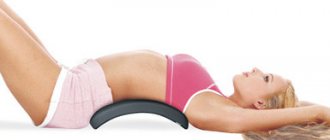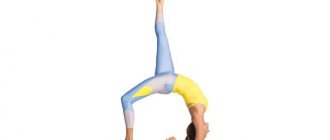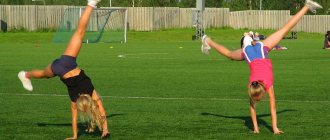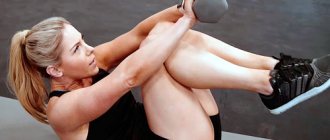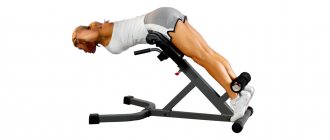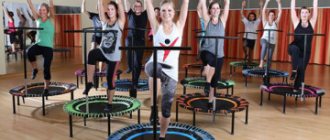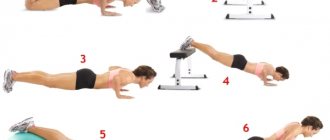Types of twine
When friends find out that a person practices gymnastics, yoga or martial arts, the first thing they immediately ask is: “Can you do the splits?” For some unspoken reason, this pose is considered the standard of flexibility, although in fact it is not very difficult for the body. Twine has two options:
- Transverse. When the legs are spread to the side, forming an angle of 180 degrees, that is, one straight line. In yoga, this position is called Samakonasana, and in society it is considered the ultimate dream of a person about a flexible body. A striking example of this is the famous stretching of Jean-Claude Van Damme, which he demonstrates in almost every film.
- Longitudinal. One leg is extended forward and the other back, also forming a straight line. In this position, it is important to keep the pelvis in a closed position without tilting it, which is a serious mistake in this position. Hanumanasana is what this pose is called in yoga, considering it very important for health. It is divided into two subtypes: right and left, with the leading leg in front, respectively.
There is also the concept of the “extraordinary” or king split, when the position of the legs exceeds the standard 180 degrees. The exercise is performed in a deep sag on blocks, chairs, as well as in a jump, standing and even in a handstand. The Internet is replete with photographs of this kind, stimulating many people to try to repeat the same thing, which sometimes ends in failure.
Learning longitudinal splits
For most people, it is easier to learn the longitudinal split - in its biomechanics, this movement resembles an extended step or running with wide steps, and the same muscles work in it. The pose should be held for 30 seconds to a minute, exercises should be done in 5–8 approaches.
- Lunges in motion. Stand straight, arms along your body. Step forward, squatting deeply on your leg, and lower the knee of the other leg closer to the floor. After pushing off with your supporting leg, return to the starting position, immediately change legs and repeat at a good pace for 3-5 minutes.
- Deep Lunge. Step forward, transfer your body weight to this leg, and place your palms on the floor on either side of your foot, with your back leg taut. Stretch forward so that your chest remains parallel to the floor. Hold the pose for half a minute or a minute.
- Back Lunge. The starting position is like a deep lunge. Lower your back leg onto your knee, keeping your front leg bent at a right angle. Place your palms or fists on your lower back and bend back, lowering the knee of your back leg to the floor.
- Lying leg raises. Alternately pull your legs as close to your chest as possible or stretch your torso towards the raised leg (you can pull your leg with an elastic band or jump rope).
The stretch gradually increases when ballistic stretching is added to the static stretch: you spring back when performing lunges, pushing off with your supporting leg during a regular lunge or with your hands from the floor during a deep lunge. To relieve pain from a muscle strain, take a hot bath with sea salt after exercise.
"Runner"
In yoga, this pose is called Ardha Hanumanasana (half monkey pose, or half longitudinal split) and is considered preparatory to the splits - Hanumanasana. Stand up straight, make a deep bend and place your palms on the floor further in front of you in line with your feet: your head between your elbows, your straightened legs and your torso with emphasis on your arms forming a triangle. This is the starting position.
- Move your left leg forward - it is bent at the knee and rests your foot on the floor between your palms.
- Place your right knee on the floor and stretch your pelvis backwards, while simultaneously straightening your left one forward (the thigh of your right leg is at a right angle to the floor).
- Straighten your back, stretch the top of your head up, feel how the muscles of the straightened front leg stretch. If possible, do several bends towards the straightened front leg, leaning on your hands. A more difficult option is bending towards the leg with arms straightened forward.
- Hold the pose as long as you can, but at least 30 seconds. Return to the starting position and repeat on the other leg.
Read more in the article “How to properly stretch on the longitudinal splits“
Is twine useful for the common man?
Anyone who is closely familiar with trying to sit in this position, performing all sorts of leading stretching exercises, sooner or later wonders what is the use of the splits. After all, its achievement is associated with pain from stretched muscles, tendons, pressure in the hip joints and aching lower back. Perhaps this situation is beautiful in appearance, but dangerous to health?
In fact, the way in which strong stretching of the body is achieved in elite sports borders on abuse of the body, since almost all actions are performed under pressure and violence, but without knowledge of the anatomical features of a person. Yoga works correctly with splits of various types and leading exercises, in which much attention is paid to correct work with the body, which means there simply cannot be any harm to it.
What are the benefits of splits?
In addition to working with energy, splits improve the general condition of the body.
Traction and strengthening
. Splits actively involve the front and inner parts of the thighs, the pelvic floor muscles - the muscular system is actively involved in the work and strengthens. The strength and flexibility of the lower body muscles support the spine and upper body. Working on opening the hips is the most difficult but necessary part of the practice, during which bodily balance is formed.
Mindfulness and self-control
. In order to correctly build an asana (the position of the legs, hips and upper body), you need to monitor the sensations that arise and understand which muscles are currently working and which are in a relaxed state. It is also necessary to monitor your breathing. Such awareness will make yoga practice safe even when performing complex asanas.
Working with muladhara and svadhisthana chakras
. The splits open the hips deeply, which activates and stimulates the lower chakras. This allows you to keep the body under control by grounding the sacral area. The sacrum in this position ensures the free flow of prana through the lower energy centers.
Splits are of particular benefit to the reproductive health of men and women. Nowadays, the level of reproductive system diseases is increasing all over the world. This is facilitated by a sedentary lifestyle, poor environment, unhealthy diet, and various infections. In such a situation, splits will help improve health, get rid of a number of problems, and even become a preventive measure against infertility. Why does this happen?
- Blood supply improves in the abdominal area and lower extremities.
- The pelvic organs receive the missing nutrients.
- The hip joints are opened, the thighs and groin area are strengthened.
- The condition of the spine and sacral joint improves.
By the way, splits are included in the yoga complex for pregnant women, since they actively involve the hip joints and pelvic organs.
Benefits of Hanumanasana
This position directly depends on the quality of extension of the two main lines of the legs: front and back. In this case, the hip joints perform the opposite function: one bends forward, and the second extends backward. At the same time, the position of the legs is significantly influenced by the sacral region and the entire group of gluteal muscles. And if they are enslaved, then you will not be able to sit in the desired position.
What is the use of longitudinal twine?
- Stretched thigh muscles indicate that there are no disturbances in blood circulation and lymph movement. This is a powerful prevention of varicose veins, swelling of the legs and diseases of the pelvic area in general. At the same time, the muscles become toned, strong, and therefore perfectly perform their function.
- Movable hip joints will not allow the development of a disease such as coxarthrosis, and will also not lead to a femoral neck fracture, which often happens in older people.
- To sit in a longitudinal split, it is necessary to qualitatively work out the area of the gluteal muscles and the sacral joint, which will allow you to quickly get rid of lower back pain, pinched sciatic nerve and displacement of the iliac bones, which happens in people leading a sedentary lifestyle. The benefits of twine in this “scourge of modernity” are priceless, because every fourth person suffers from pain of this nature.
Technique: what and how to pull?
- Starting position – standing. The back is straight, looking forward. Slowly tilt your head down as far as possible. At the end point, fix the position for 10 seconds. We return to the starting position.
- We repeat the same steps, but with the head tilted back. We do not open our mouth.
- Now we tilt our head to the left - and we help press it to the shoulder with our left hand (the shoulder itself does not rise). The same fixation - but for 20 seconds. We return to the starting position.
- We repeat the same steps, tilting our head to the right.
- We begin slow rotations of the head clockwise. Then do the same - counterclockwise (10 turns in each direction).
The exercise is done at a wall bars or other vertical support.
- Starting position – standing sideways to a support at arm’s length.
- We lean our hand on the wall and begin to unfold the body. Do this until you can maintain balance, do not move your legs and feel tension in your shoulder and biceps (but without pain).
- At the end point, fix the position for 30 seconds. We return to the starting position.
- We turn to the support with the other side and do the same with the other hand.
Triceps
How to do a triceps stretch?
- Starting position - standing, one arm bent, its palm placed on the opposite shoulder.
- With the palm of the second hand, we take the elbow of the first from below and slowly pull it as far as possible, trying to bring the elbow almost to the opposite shoulder.
- We fix the position for 30 seconds, return to the starting position and change hands. Repeat 10–15 times.
For this we need bars.
- Starting position – standing, hands resting on the bars from the elbow and above.
- Slowly bend your legs, lowering your body down to the maximum possible (it can be easily determined by the increase in pain).
- We fix the position for 30 seconds and return to the starting position. Repeat 10–15 times.
The simplest method because it does not require any equipment.
- Starting position: lying on your stomach. Hands in the same position as before push-ups.
- Slowly straighten your arms, lifting only the upper part of your body from the floor, bending your spine back.
- We fix the position for 30 seconds and return to the starting position. Repeat 10–15 times.
Upper back
How do we stretch?
Starting position – standing, chest slightly arched, breathing even.
- We round our back, sticking out our chest, while simultaneously stretching our arms and shoulders down and forward to balance (the chin also tilts a little).
- Having reached the limiting point, we also, slowly, straighten up.
Fixing the final position is not necessary here, and the maximum load should be felt in the area of the shoulder blades. If the tension occurs in the wrong place, we try to correct the movements until we achieve the desired result. Repeat 10–15 times.
The most difficult exercise for beginners (provided they strive to perform it correctly).
- Starting position – standing.
- As you exhale, WITHOUT BENDING YOUR KNEES (this is important!), lean forward and reach for the floor with your fingertips. If there is no flexibility in the muscles, this will not be possible at first. But you need to repeat the exercise (again and again, day after day) until, when you bend over, you can touch the floor with your open palms.
- As you exhale, take the starting position.
How can a man do the splits? As a rule, they are not able to do this as quickly as women. However, you need to strive for this.
The first step in this will be the following exercise:
- Starting position – sitting on the floor. Bend your legs at the knees, spread them apart and pull your heels as close to your buttocks as possible, moving your feet.
- We put our hands on our knees and begin to smoothly, but with effort, spread them to the sides and down in such a way as to try to press them to the floor.
- It doesn’t matter to what level you can lower your knees the first, second, and so on. The main thing is to fixate at the lowest point where moderate pain can be tolerated, and hold in this position for up to half a minute.
The second step will be an exercise that is performed immediately after the previous one.
- Starting position - standing, with your hands holding onto a support (for example, a wall bars or the back of a high and heavy chair), legs set as wide as possible (as far as possible).
- Slowly we begin to spread our legs even wider, moving our feet. Each time we will fall lower and lower - and even if we do not reach the level of sitting in full splits, we can be satisfied with the result in which about 10 cm will remain to the floor.
- We fixate in the lower position for 20–30 seconds.
- Just as slowly and carefully we return to the starting position.
- Starting position – standing, with your hands holding the supports on both sides (left and right).
- Without bending your knees, we put one leg forward as far as possible.
- Slowly we begin to spread our legs further forward and backward.
- As in the first case, lowering the pelvis to a height of 10 cm from the floor can be considered satisfactory.
- We fixate in the lower position for 20–30 seconds.
- We repeat as much as we can.
Horizontal bar
It's easy enough to hang on. Often, at any time and without restrictions. Such a hang relieves the spine perfectly, and at the same time trains the strength of the hands.
You need to know this!
Working with the twine allows you not only to loosen the pelvis, but also to remove the load from the entire spine, since the hip joints are the main shock absorbers of the body. If the joint is not blocked by tight tendons or constrained by muscles, then it has a free range of circular movements. Pain along the entire spinal column goes away, posture improves, as the leg muscles, and therefore the joints, finally begin to work harmoniously, granting freedom of movement. The benefits of leg splits extend in the other direction. Since the area of the hip joints is relaxed and correctly distributes the load on the spine, the knees (the second most important shock absorbers) stop receiving extra stress and, therefore, getting sick.
Important benefits for the female body
Thanks to the high-quality stretching of the internal muscles of the legs and pelvis, directly connected by the abdominal area, the benefits of twine for women increase several times:
- Active blood circulation in the pelvic area eliminates various disorders of the reproductive system. In the history of medicine, there are thousands of cases that describe the elimination of problems with conceiving a child. Thanks to the fact that the woman did stretching exercises to do the splits, she was able not only to get pregnant, but also to give birth easily, since the internal muscles were obedient and healthy.
- Also, thanks to good blood circulation, gynecological problems go away: inflammatory processes, menstrual irregularities, painful periods and other unpleasant moments of “female” existence.
At the same time, we should not forget that the abdominal zone is responsible for the coordinated functioning of the entire digestive tract, and therefore for the health of the entire body. Therefore, the health benefits of splits can be considered total, that is, affecting not only the legs, but the whole body as a whole.
Why do men need stretching?
For men, there is a direct relationship between sexual health and the development of body flexibility. There are at least three reasons for this.
- Stretching for men promotes active blood circulation in the pelvic area. As a result, the vessels receive enough blood - and an erection, in essence, occurs due to a sharp rush of blood to the male genital organ.
- Developed muscles are the best protection against pinched nerve fibers. After all, the source of this problem is compaction and compression of the vertebrae, which occurs due to weak support of the spinal column by the back muscles.
- The health of the body directly affects the psycho-emotional state - and many of the problems of men in bed are related specifically to the psyche. Moreover, the very first failure often causes an avalanche-like process of increasing fear before each subsequent sexual intercourse. But switching to the use of drugs that enhance potency is definitely not the best way out of the situation, and this will cause much more harm than good.
How to do this or that type of stretching if you are a beginner? And should you immediately worry that without the ability to professionally do the splits and arch a bridge, your classes cannot be considered full-fledged? Of course, the benefits of splits for men are undeniable - however, this is far from the first and not the main step in the art of creating a flexible and strong body. It is much more important to start with basic tasks - improving blood circulation in the pelvic area and relieving tension in the spinal column.
This can be achieved by performing special gymnastics for beginners, the first lessons of which can be obtained at a fitness center from experienced instructors, or you can immediately start practicing at home (fortunately, photos and videos of all useful exercises can be easily found on the Internet).
What tips should you not neglect when starting to stretch at home, in the gym or at the stadium?
- The main thing is to warm up! You can’t start straining “cold” muscles. The best option is a light cardio warm-up and gymnastic exercises for the joints for 10–15 minutes.
- "Hurry up slowly"! This catchphrase suits our task perfectly. Sudden movements when stretching are contraindicated - but slow and smooth movements, on the contrary, ideally help strengthen the muscles and make the ligaments elastic.
- Don't break the technique! Otherwise, pain and even injury will begin to haunt you, and the effect of the exercises will be much lower than you would like.
- Don't make classes a competition! Your workouts are for you, not for spectators. There is no need to try to get ahead of someone or prove something to someone.
- Exercise regularly! At least three times a week. And combine exercise with proper nutrition, light jogging, cycling, swimming or any other form of light cardio. If you add moderate power loads to this, the result will not be long in coming!
Remember one more important thing - ANY person can do stretching (except perhaps those for whom it is contraindicated due to serious disorders of the body). The main thing is to increase the load gradually and do it with pleasure!
There are different types of stretch marks - and each of them has its own purpose.
- Passive stretching. The slowest type, involving complete control over the muscles. To do this, the application of force must be long-term and external - that is, provided by a simulator, an exercise partner, or some kind of load. Its goal is to stretch the ligaments and muscle fibers as much as possible, but with virtually no pain.
- Active stretching. With it, the force is achieved through its own movement. At the same time, the muscles contract more actively, and the tension is at the limit of the athlete’s capabilities.
- Ballistic stretch. Ballistics is aimed at movements with acceleration, and therefore requires experience and extreme attention (otherwise you can tear muscle fibers and damage joints). However, it is also necessary, since the types of loads on the muscles should not only be static.
Cross split, or Samakonasana
If the longitudinal split mainly depends on the elongated muscles, then the transverse split is an indicator of the total freedom of the hip joints, their interaction with the entire pelvis, and therefore the elastic tendon apparatus. It is important to emphasize here: elastic, not stretched, since young and ignorant people often “loose” their joint structure in pursuit of the desired position, not understanding what this entails.
In fact, any split (and especially the transverse split) does not mean superflexibility, but skillful use of the body, knowledge of its structural features. After all, by and large, sitting in any position is not a problem, but staying healthy for the longest possible number of years is much more important, deriving significant benefits from the cross splits. It is important to prioritize health, not a spectacular-looking position for photos on social networks.
The benefits of twine for the mind
We all perceive the world differently. Someone is open to new knowledge and gratefully accepts all life lessons. Others are characterized by stereotyped thinking and conservative views on life. “What does asana have to do with it?” you ask. The fact is that the flexibility of our thinking often depends on the flexibility of the body. There is even a saying: “Blessed are the flexible, for they cannot be put in an awkward position.” And the best way to develop mental flexibility is to develop body flexibility. And twines are perfect for this purpose.
Like other complex asanas, shapagat has a pronounced psychological effect. On the one hand, any achievement is an indicator of efficiency, willpower and patience. On the other hand, there is a danger here that the practitioner will begin to approach yoga from the point of view of the ability to perform complex asanas and forget about its true purpose - to work with the enslavement of the mind by influencing the body. Therefore, it is important to remember that performing complex asanas is not a goal, but a consequence of the right approach to yoga.
Advantages of Samakonasana
In addition to all the above positive aspects from mastering longitudinal twine, without which it is impossible to make transverse twine, it is worth pointing out the following factors:
- Deeper connections between internal muscles and their control ultimately result in absolute health of the genitourinary system.
- The benefits of splits for women are invaluable: thanks to the tone of the pelvic diaphragm, the problem that bothers them in middle age - urinary incontinence during a sharp sneeze or fright, as well as prolapse or prolapse of an organ, which is called “uterine prolapse”, goes away. By increasing the elasticity of the muscular-ligamentous apparatus of the inner surface of the pelvis, all these problems will gradually go away.
- The possibility of getting pregnant if you had problems conceiving before is significantly increased, and it is also easy to give birth, since the pelvic area retains mobility and a large range of movements, and the abdominal area retains elasticity.
In addition to all the positive aspects associated with the internal organs, the cross split will visually make your legs slimmer, more toned, and your buttocks more elastic and rounded. This is also important for women, because external beauty and internal health always go hand in hand.
Can children do the splits?
Some concerned parents whose kids attend gymnastics classes ask: “Are splits beneficial for children or is it harmful at a young age?” Among unenlightened people, there is an opinion that too deep split stretches can change the structure of the developing reproductive system of a child and even tear the hymen from excessive effort (there are people who really believe in this even in the 21st century!).
Professional sports doctors unanimously reject these delusional thoughts: splits can be done at any age, unless there are special indications for this due to major health problems. Moreover, there are no clear age restrictions at what age it should be started - even from the cradle, as long as it is done competently and wisely, and not at the cost of superhuman efforts, as happens in big sports.
Can you do the splits at any age?
Considering the popularity and promoted benefits of the splits, many people are wondering at what age they should stop trying to perform this exercise, because most confidently claim that after 35 there is no point in even trying, since the body is already “ossified.” In fact, it is not age that limits movements in muscles and joints, but their condition, as well as the congenital structure of the pelvis. There is a small percentage of people for whom the transverse split is inaccessible due to the small angle between the acetabulum and the femoral head, but they can perform the longitudinal split. Over time, the human body becomes tight due to low physical activity, past illnesses and injuries. But if a person actively engages in stretching, then he will be able to do the splits even in old age.
Why do the splits
If you are reading these lines, most likely you know why you need twine. But even if not, I will give you several reasons to read to the end of the article and incorporate stretching exercises into your daily routine.
The benefits of stretching are: joint mobility and lack of pain when moving.
Treatment and prevention of age-related diseases and diseases associated with circulatory disorders.
For older men, split exercises are especially useful, as they improve blood supply to the pelvic joints.
For martial artists, it is much easier to perform high-level kicks and technical techniques in wrestling.
Splits are not a goal, but a means to improve the overall well-being and flexibility of the whole body.
Basic principles of flexibility
Flexibility is the ability to control the amplitude and direction of your movements in the joints. Every person has limitations in movement. To combat restrictions, special exercises called stretching are used. They increase the length of muscles and ligaments
Jujimufu proposed to classify flexibility according to the type of muscle activity and the use of external forces to increase amplitude. Of greatest interest to us are:
- Dynamic active flexibility
- Static active flexibility
- Static passive flexibility
Dynamic active includes swinging arms and legs with full amplitude, while the stretched muscles are relaxed, and the movement occurs due to the tension of the antagonists.
Static active allows you to maintain the adopted position only by the strength of the muscles of the protogonists. As an example, holding a high leg in taekwondo athletes. This is isometric.
Static passive involves taking and maintaining static positions with the help of a partner, your own weight, the weight of a barbell, or the use of elastic bands.
Flexibility Factors
There are a lot of such factors. Your flexibility is affected by:
- Shape and structure of the joint. Ligaments and tendons also affect flexibility
- Women are naturally more flexible, if you're a man you're out of luck
- Flexibility decreases with age. This deterioration can be reversed with regular exercise.
- Emotional state affects flexibility. The next time you have wings of joy, immediately fly into the splits. While negative thoughts and fatigue impair flexibility and coordination
- Times of Day. You've probably noticed that it's harder to stretch in the morning.
- Preliminary exercises and warming up the muscles. Before doing the splits, you need to do a few preparatory exercises.
- If you do dynamic exercises when you are tired, your amplitude can greatly decrease. Therefore, the order of the exercises is important.
- Each exercise has its own technique. Incorrect technique interferes with stretching progress.
- Sudden uncontrolled movements pose a health hazard. Watch for smoothness and amplitude
- Isometric stretching is better than static stretching and gives faster results. But more dangerous to use
- Insufficiently strong muscles also slow down your stretching. The stronger you are, the better
- Restricted joint movement can reduce your stretch. For example, long training sessions on roller skates or ice skating. So don't forget to stretch these muscle groups after these workouts.
- Body and ambient temperature affect your flexibility
Can twine be harmful?
The harm, as well as the benefit, of twine is a very subjective assessment. Some active people do not have a problem with stagnation of lymph or blood in the pelvic organs, so they do not consider eliminating these factors as advantages - they already exist a priori. The dangers of splits and deep stretches of this kind can only be discussed in one way: when they are performed fanatically, in pursuit of an external result, rather than health.
Many young people earnestly begin to pull and stretch the tendons, not understanding what actually leads the body to the split position, so later, when the stability of the center of the body is disrupted, problems will begin: immediately with the joints of the legs, then the sacrum and, as a result, the entire spine. Therefore, it is important to competently approach the development of all splits, preferably under the guidance of a competent trainer.
Are there any contraindications?
There are no significant “cons” in pursuit of the benefits of splits, but a number of “buts” are worth considering:
- previously received fractures of the femoral neck or pelvic bones, as well as spinal fractures;
- destructive changes in the hip joints: arthrosis and especially coxarthrosis, various arthritis;
- hip dysplasia.
In addition, existing problems with the spine, whose work is directly related to the pelvis, as well as hypertension and cancer, should be taken into account.
What do the experts say?
Another important advantage of working with twine is noted by many doctors - it is the effect on libido in women and potency in men. Therefore, for some people, this information will be another incentive to regularly stretch.
Another significant benefit of twine for men is the elimination of problems with the prostate, since when acting on the internal muscles of the pelvis, this organ is perfectly enriched with blood. Congestion that occurs due to insufficient activity of the pelvic cavity is eliminated. Therefore, it is important to do the splits for men who want to maintain sexual activity for a long time.
